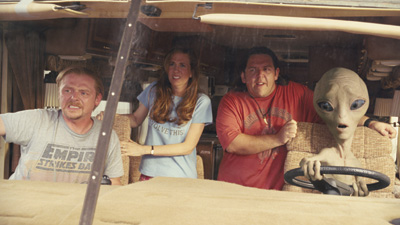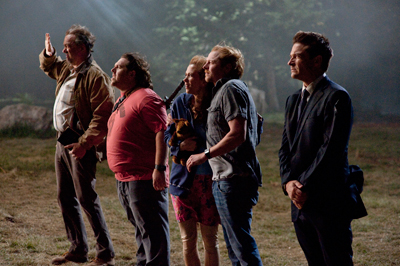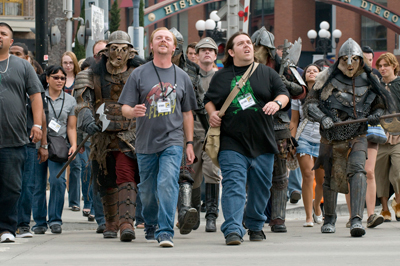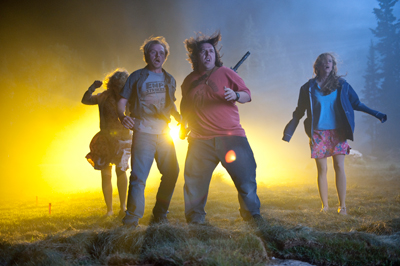Simon Peg & Nick Frost Paul cont

Paul
Cast: Simon Peg, Nick Frost, Jason Bateman, Kristen Wiig, Bill Hader, Blythe Danner, Joe Lo Truglio, John Carroll Lunch, David Koechner, Sigourney Weaver, Seth RoganDirector: Greg Mottola
Genre: Comedy, Sci-Fi
Synopsis: Simon Pegg and Nick Frost (Hot Fuzz, Shaun of the Dead) reunite for the comedy adventure Paul. As two sci-fi geeks whose pilgrimage takes them to America's UFO heartland, they encounter a wisecracking alien and help him on a daredevil quest that will alter our universe forever.
Release Date: April 14th, 2011
Behind the scenes with Simon Peg & Nick Frost Paul Part 1
www.girl.com.au/simon-peg-nick-frost-paul.htm
Travelin' America: Design and Locations
While Greg Mottola has won respect for his fluid visual style as a comedy director, a comedy-adventure such as Paul required an expanded vision. For visual reference, Greg Mottola drew from the work of Steven Spielberg-everything from the director's film debut, The Sugarland Express, to his sci-fi masterpieces Close Encounters of the Third Kind and E.T.: The Extra-Terrestrial.
But Greg Mottola's vision, while containing the high-gloss elements of Steven Spielberg, also incorporates a ragtag look that keeps this production true to his roots as an independent filmmaker from such productions as The Daytrippers. Such visionary ambitions would seem to be at odds with characterizations of "laid-back" and "easygoing," which are how cast and crew describe Greg Mottola. Yet, it fits precisely with the kind of confidence Greg Mottola displayed in his overall vision.
The director's calm demeanor was even more remarkable in light of the fact that, despite the genesis of Paul as a film Simon Pegg wanted to shoot anywhere but underneath England's rainy umbrella, the weather throughout the shoot remained unpredictable. "We had hail storms and lightning and far more rain than we had back in England," shares Nira Park. "The original idea came from wanting to shoot in America, where the weather would be good. Instead we were challenged every day by the weather."
Simon Pegg admits he traded the challenges of one inclement climate for another: "We wound up shooting in one of the most changeable places in the world. It would be blazing sunshine one minute and 20 minutes later there'd be hailstones the size of golf balls. Sometimes we had to take cover due to lightning storms. There was even a device on set to ensure we were a safe distance away from electrical storms, because apparently a lot of people get struck by lightning in New Mexico."
Of course, a director's vision is only as good as the people who execute it, and Greg Mottola assembled a crackerjack team of behind-the-scenes wizards to realise the deceptively complex challenges of creating the world according to Paul.
Though the film is set in various areas of the American Southwest-from Comic-Con in San Diego to the Devil's Tower in Wyoming (famously used in Close Encounters of the Third Kind)-Paul was shot almost exclusively in New Mexico. Concocting a convincing landscape that fit all the script's demands would be easier than one might imagine. In fact, within one hour's drive of Santa Fe can be found the type of harsh desert that feels like Nevada, as well as mountains that would make the observer swear he or she was in Wyoming or Colorado. The road trip was born.
 One of the first steps in coordinating this visual sleight of hand began as Greg Mottola, production designer Jefferson Sage and line producer/executive producer Robert Graf sat down with J. Todd Anderson, the storyboard artist who has worked for Joel and Ethan Coen for many years. A key part of Greg Mottola's early process in conceptualizing the movie and translating the script into visual terms, Anderson worked with the director for approximately three months to storyboard the film.
One of the first steps in coordinating this visual sleight of hand began as Greg Mottola, production designer Jefferson Sage and line producer/executive producer Robert Graf sat down with J. Todd Anderson, the storyboard artist who has worked for Joel and Ethan Coen for many years. A key part of Greg Mottola's early process in conceptualizing the movie and translating the script into visual terms, Anderson worked with the director for approximately three months to storyboard the film. Making the storyboards three-dimensional and bringing visual texture to Paul was the task at hand for Jefferson Sage, with whom Greg Mottola had previously collaborated on the cult television comedy series Undeclared. For a road-trip picture that covers a lot of territory, it is decidedly curious that one of his primary functions was to create the movie's main set, a battered recreation vehicle. Still, Jefferson Sage explains: "The RV is where we spend most of our time and where most of the action occurs."
Naturally, the look of the RV needed to match the eccentric characters driving it. "We agreed that it should be an older-style vehicle since these guys wouldn't go top-of-the-line and were probably on a bit of a budget," explains Jefferson Sage. "We started looking at RVs from the '70s and '80s." The finished product, known in the script as a Beagle Traveler, was an amalgam of two models: a late-'80s vintage Winnebago (whose silhouette served as the vehicle's exterior) and another RV called a Bounder (the majority of which was used for fashioning the interiors).
Two functioning RVs were utilised for the road scenes, and a third was crafted for sequences shot on a soundstage. This final RV was known as the Hero RV because all its interior parts could be removed to allow the camera and crew to light it and shoot in it.
A much broader challenge was re-creating the biggest comic convention on the planet, San Diego's Comic-Con, using the 100,000-square-foot Albuquerque Convention Center to serve as Comic-Con's double. Dressing the set to look like the real thing involved countless clearances from the many participants and stakeholders of the actual event.
Re-creating the behemoth annual convention was a labor of love for Greg Mottola's cast and crew. He provides: "We all had fun with Comic-Con. We all grew up on comic books and science fiction and just wanted to get it right. We didn't want it to become a cheap joke, and we knew it had to look like the real thing."
To stand in for Wyoming, regions of the small town of Las Vegas, Nevada, were used and a large, open meadow in the mountainous regions near Santa Fe served as the site of Wyoming's Devil's Tower, with the iconic tower later added by the visual effects team. This meadow was also where Sage built the bottom half of Paul's spaceship. Similar to the tower, the VFX team also later digitally created the top of the craft.
A different kind of visual trickery was required for Simon Pegg and Nick Frost to visit the Vasquez Rocks outside Los Angeles. Famously used in a classic Star Trek sequence, the geologic formation was a logical draw for studied geeks Graeme and Clive. Jefferson Sage sent a second unit crew to capture exteriors of the Vasquez Rocks. Back in New Mexico, Greg Mottola and DP Sher shot Simon Pegg and Nick Frost's movements as Graeme and Clive. Then, much like a composite photograph, the two scenes were married.
As well, Jefferson Sage fashioned the mysterious White Mailbox that once stood on the road near the infamous Area 51 in central Nevada. To set the scene, he used a barren stretch of desert highway in New Mexico that closely resembled this region of Nevada.
Jefferson Sage found a kindred spirit in his efforts in Greg Mottola, who went to art school before becoming a director. "With Greg Mottola's art school background, he was very involved in the visuals and the images he wanted in the movie and how they could also be layered with comedy," the production designer notes. "We ended up with a modern concept of what science fiction is...a romantic version of it."
Special-effects coordinator Larz Anderson knew his work would be cut out for him after he finished Simon Pegg and Nick Frost's SFX-laden screenplay. "This was one funny script, but it had a lot of interesting challenges," he states. "We had a house to blow up, which is always fun, and we got to set off fireworks in the middle of a national forest, which is problematic to say the least...but oh so interesting."
Among his less exotic assignments was to make the soundstage RV move as if it were on the open road...with Paul, Graeme and Clive flying down the highway. "We built a two-axis gimbal on airbags so we could shake it," says Larz Anderson. "With pneumatic rams we added braking so when the characters slammed on the brakes, the whole vehicle went forward while we dumped out some cabinets so things fell on them. It was quite dramatic."
 Much more fun, Larz Anderson admits, was the gas explosion at a farmhouse, a major set piece in the film. The stunt was broken down into two elements. On a soundstage, propane mortars were put inside the stove to create a controlled fireball that gave an inside look at the explosion from within the house. Then, on location, the specially built house was constructed with a thin frame so it would blow up easily without having to be overloaded with explosives. "This way," Larz Anderson points out, "we could make it collapse into a pile of rubble at the end."
Much more fun, Larz Anderson admits, was the gas explosion at a farmhouse, a major set piece in the film. The stunt was broken down into two elements. On a soundstage, propane mortars were put inside the stove to create a controlled fireball that gave an inside look at the explosion from within the house. Then, on location, the specially built house was constructed with a thin frame so it would blow up easily without having to be overloaded with explosives. "This way," Larz Anderson points out, "we could make it collapse into a pile of rubble at the end." Even more daunting was the aforementioned shooting off of fireworks in a national forest, which required a heavily concerted effort between the locations department and the U.S. Forest Service. The SFX coordinator recounts: "We showed them demonstrations of what we were going to do and ended up bringing in a fire crew to stand by and check on moisture levels and scout the fallout zone afterwards to make sure it was all safe. In the end, it went off rather well."
Geek Chic: Costumes of the Comedy-Adventure
Costume designer Nancy Steiner is no stranger to the needs of movies set in the present, though this one did dramatically expand her knowledge of cotton T-shirts. "Graeme and Clive are comic-book geeks, so they don't have a lot of fashion sense," she says. "But they are aware of what they're wearing. They're very proud of their comic books and sci-fi T-shirts."
Most of her work for the two characters involved navigating "the hell of clearances" in order to dress the characters in visually arresting tee-tops. One coup was getting permission from Lucasfilm to use Star Wars-themed tees. Her team also received a terrific image from Dan Clowes, creator of the character Eightball and a T-shirt with the image of Ming the Merciless from "Flash Gordon" and Project Superpowers from the graphic novel "Dynamic Forces."
Nancy Steiner was fortunate that most of the dozens of extras for the Comic-Con scenes came prepared with their own costumes (translation: well-worn, awesome nerd shirts, Princess Leia, Darth Vader, Stormtrooper, various sci-fi and Anime character costumes). She found these more authentic because they were made with love and passion and were quite individual.
Offers Greg Mottola: "When we started I was adamant that what the costumes people wore had to feel real. These had to be a mix of the people who either spent the money to get an expensive Stormtrooper outfit or spent the time to do it right and make their own thing and put a lot of love into it. I didn't want it to feel entirely like rented costumes. Little did I know, the people who go to Comic-Con who live in New Mexico were more than happy to show up in their full array of space gear. We had any number of Anime characters and Star Trek and Star Wars folks from all over the state. Some drove themselves in from neighboring states because they wanted to be part of it."
Greg Mottola was particularly amazed at the rights his designers were able to secure from enormous franchises. "It was amazing to get Lucasfilm to let us use Star Wars and Paramount Pictures to let us use Star Trek characters, copyrighted images, throughout the film. They were incredibly generous and got the joke of the movie. They were completely on board with the spirit of it."
Designer Nancy Steiner also had the unique assignment of outfitting the CGI character Paul. "He wears shorts and flip-flops, but we had to camera test a number of shorts before we found the right ones to go with the color of his skin. We also got together a little cowboy outfit for him to wear when he's in disguise."
Though most of the characters in the film wear one or two outfits throughout-very much in keeping with their backgrounds and careers-Ruth undergoes an evolution in the movie and Nancy Steiner subtly traces it through her apparel choices. "She's very conservative and not very current in her clothing, but I didn't want to make her buttoned-up and clichéd at the start.
When the boys meet (before they accidentally kidnap) Ruth, she's wearing tees with the caption "Evolve this!" and a picture of Jesus ready to attack Darwin. These reflect the extreme of her anti-evolutionary beliefs. But as she changes, so does her look, which becomes a bit looser and a little sexier. "Just a bit," mentions Nancy Steiner. "Not too much. We didn't want her to get too trashy."

MORE





